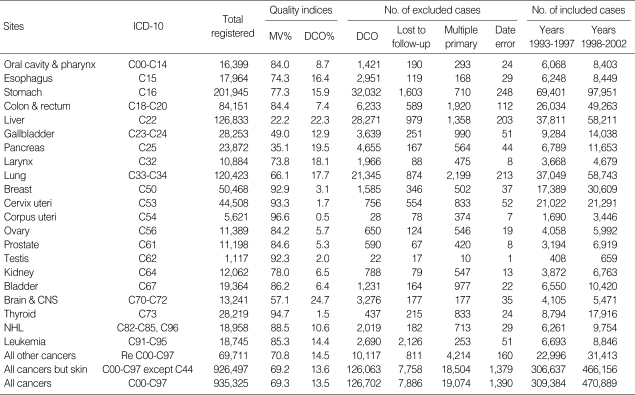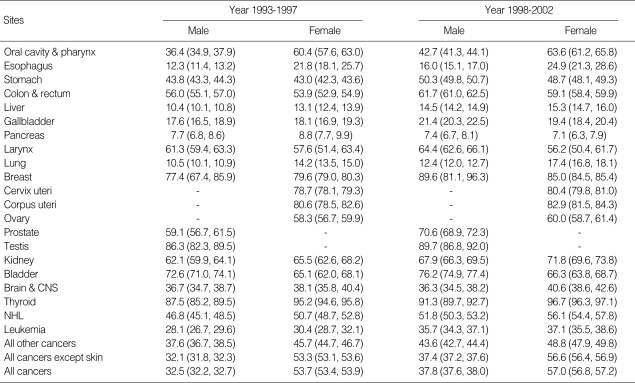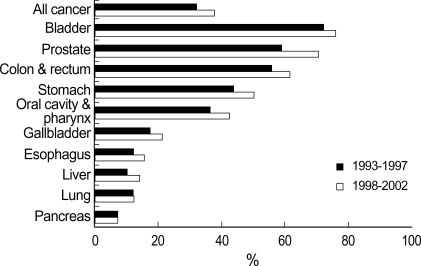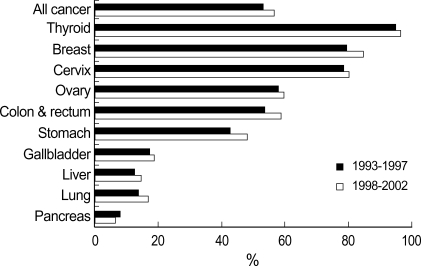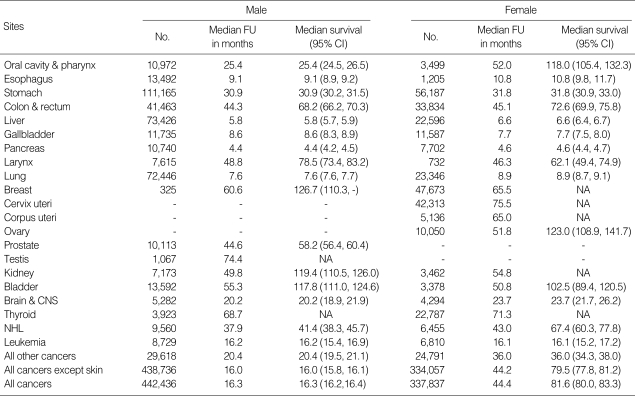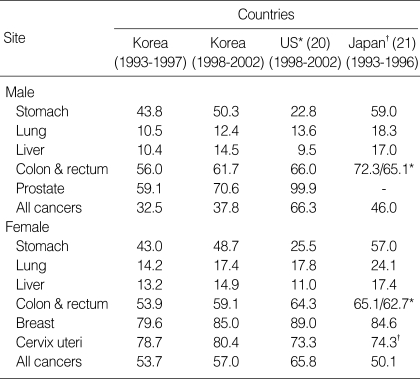Abstract
Population-based survival reflect the average prognosis of unselected patients with a variety of natural histories as well as treatment patterns and are also useful for evaluating effectiveness and efficiency of cancer-directed health services in a given region. Although survival data have been reported based on hospital data, the survival data from population-based registry have been rarely reported in Korea. Based on the Korea National Cancer Incidence Database, we report the results from survival analysis for cancer patients diagnosed during 1993-2002 and followed up until 31 December 2005 at primary cancer sites. The five-year relative survival rates (RSR) were calculated using the Ederer II method. The Kaplan-Meier method was used to estimate median survival and the 95% confidence intervals. In males, the five-year RSR for all cancers was 32.5% during 1993-1997 and was 37.8% during 1998-2002. In females, the five-year RSR for all cancers was 53.7% during 1993-1997 and was 57.0% during 1998-2002. The largest improvement in survival was shown in prostate cancer in males and breast and stomach cancer in females. The median survival durations were 16.3 months in males and 81.6 months in females. This result will be useful for evaluation of cancer treatment outcomes in Korea.
Keywords: Cancer Registry, Survival, Korea
INTRODUCTION
Survival estimates of patients registered by population-based cancer registries reflect the average prognosis from a given cancer, since they are based on unselected patients with a variety of natural histories as well as treatment patterns. Population-based cancer survival data are also useful for evaluating effectiveness and efficiency of cancer-directed health services in a given region. Although survival data have been reported for selected cancer sites from hospitals, the survival data from population-based registry data have been rarely reported in Korea (1, 2).
The Korea Central Cancer Registry (KCCR) began as a nationwide hospital-based program in 1980. The operational details of cancer registration have been previously described (3). The KCCR constructed the Korea National Cancer Incidence DataBases (KNCIDB) by merging the KCCR databases and eight Population-Based Regional Cancer Registry databases, the site-specific cancer registry databases (breast, ovary, uterus, and liver cancer) and additional data from medical record review surveys. Using this KNCIDB and other sources such as mortality data from National Statistical Office, it became possible to produce national survival rates. In this paper, we report the results from survival analysis for cancer patients diagnosed during 1993-2002 in Korea at primary cancer sites.
MATERIALS AND METHODS
The data in this study were based on the KNCIDB. A total of 935,325 cancer patients diagnosed from January 1, 1993 to December 31, 2002 were included.
Table 1 shows the quality indices, numbers and proportion of included and excluded cases. The Morphological Verification (MV) %, an indicator of the validity of the diagnostic information, is the percentage of cases for which the diagnosis was based on morphological verification of a tissue specimen. Overall, MV% was 69.3% (n=648,615), ranging from 22.2% in liver to 94.7% in thyroid. Death certificate only (DCO) % was the percent of cancer cases recognized by only the mortality records, which is another indicator for the validity of the data. Overall, DCO% was 13.5% (n=126,702), ranging from 0.5% in Corpus uteri to 24.7% in Brain and CNS.
Table 1.
Data quality indices, numbers and proportion of included and excluded cases
CNS, central nervous system; NHL, non-Hodgkin's lymphoma; MV, Morphological verification; DCO, death certificate only.
A total of 126,702 DCO cases (13.5%) were excluded from the survival analysis. Furthermore, 7,886 cases (0.8%), that could not be followed up due to mismatched Personal Identification Number, 19,074 cases (2.0%), that were not first primary sites, and 1,390 cases (0.1%) with mismatched dates were excluded from the analysis.
A total of 780,273 cases (83.4%) were eligible for final analysis. Passive follow-up was performed until 31 December 2005. The survival duration of each case was determined as the time difference (in months) from the date of initial diagnosis to the date of death, date of loss to follow-up, or the closing date for follow-up. Cancer was classified according to the International Classification of Diseases, the 10th revision (ICD-10).
Five-year relative survival rates (RSRs) and the median survival time were calculated. Relative survival was defined as the ratio of the observed survival rate to the expected rate; this was based on a group of people in the general population similar to the patient group with respect to race, sex, age and calendar period of observation (4). It means the survival experience of patients are adjusted for normal life expectancy of the general population of the same age, which makes relative survival rate an estimate of the chance of surviving the effects of cancer (5).
The RSRs were calculated using the Ederer II method (6). Relative survival analyses were based on an algorithm written in SAS by Paul Dickman (7) with some minor adaptations. Asymmetric observed survival confidence intervals (CIs) were formed from standard errors estimated using the Greenwood's method (8) and the log (-log) transformation. RSR confidence limits were derived by dividing the observed survival limits by the corresponding expected survival rate (4).
The median survival using the Kaplan-Meier method and its CIs were also calculated (8).
RESULTS
Relative survival (Table 2, Fig. 1, 2)
Table 2.
Five-year relative survival rates and 95% confidence intervals by cancer site and sex Unit: % (95% CI)
CNS, central nervous system; NHL, non-Hodgkin's lymphoma.
Fig. 1.
Five-year relative survival of 10 major cancers in Korea, male, 1993-2002.
Fig. 2.
Five-year relative survival of 10 major cancers in Korea, female, 1993-2002.
In males, the five-year RSR for all cancers combined was 32.5% (95% CI 32.2-32.7) during the period 1993-1997 and was 37.8% (95% CI 37.6-38.0) during 1998-2002. In females, the five-year RSR for all cancers was 53.7% (95% CI 53.4-53.9) during 1993-1997 and was 57.0% (95% CI 56.8-57.2) during 1998-2002.
The 10 most common cancer sites in males were stomach, liver, lung, colon and rectum, bladder, esophagus, gallbladder, pancreas, prostate, and oral cavity & pharynx and five-year RSRs for these cancer sites were 43.8% (95% CI 43.3-44.3), 10.4% (95% CI 10.1-10.8), 10.5% (95% CI 10.1-10.9), 56.0% (95% CI 55.1-57.0), 72.6% (95% CI 71.0-74.1), 12.3% (95% CI 11.4-13.2), 17.6% (95% CI 16.5-18.9), 7.7% (95% CI 6.8-8.6), 59.1% (95% CI 56.7-61.5), and 36.4% (95% CI 34.9-37.9) during 1993-1997, and were 50.3% (95% CI 49.8-50.7), 14.5% (95% CI 14.2-14.9), 12.4% (95% CI 12.0-12.7), 61.7% (95% CI 61.0-62.5), 76.2% (95% CI 74.9-77.4), 16.0% (95% CI 15.1-17.0), 21.4% (95% CI 20.3-22.5), 7.4% (95% CI 6.7-8.1), 70.6% (95% CI 68.9-72.3), and 42.7% (95% CI 41.3-44.1) during 1998-2002, respectively.
In the females, the 10 most common cancer sites were stomach, breast, cervix uteri, colon and rectum, lung, thyroid, liver, gallbladder, ovary, pancreas, and the five-year RSRs for these cancer sites were 43.0% (95% CI 42.3-43.6), 79.6% (95% CI 79.0-80.3), 78.7% (95% CI 78.1-79.3), 53.9% (95% CI 52.9-54.9), 14.2% (95% CI 13.5-15.0), 95.2% (95% CI 94.6-95.8), 13.1% (95% CI 12.4-13.9), 18.1% (95% CI 16.9-19.3), 58.3% (95% CI 56.7-59.9), 8.8% (95% CI 7.7-9.9) during 1993-1997, and were 48.7% (95% CI 48.1-49.3), 85.0% (95% CI 84.5-85.4), 80.4% (95% CI 79.8-81.0), 59.1% (95% CI 58.4-59.9), 17.4% (95% CI 16.8-18.1), 96.7% (95% CI 96.3-97.1), 15.3% (95% CI 14.7-16.0), 19.4% (95% CI 18.4-20.4), 60.0% (95% CI 58.7-61.4), and 7.1% (95% CI 6.3-7.9) during 1998-2002, respectively. The largest improvement in survival was shown in prostate cancer in males, and stomach and breast cancer in females. Most cancers diagnosed during 1998-2002 had higher relative survival than during 1993-1997, except for pancreatic cancer.
Median survival (Table 3)
Table 3.
Median survival and 95% confidence intervals (in months) by cancer site and gender during the period 1993-2002
CNS, Central nervous system; NHL, Non-Hodgkin's lymphoma; NA, Not available, If more than 50% of the subjects are alive at the end of the study, then median survival cannot be computed; FU, Follow up; CI, Confidence interval.
The median survival time by sex was shown in Table 3. The median follow-up time was 16.3 months in males and 44.4 months in females.
The median survival time for all cancer patients was 16.3 months in males and 81.6 months in females. Female cancer patients survived significantly longer than male cancer patients. The median survival time for stomach, liver, lung, and colon and rectal cancer in males were 30.9 (95% CI 30.2-31.5), 5.8 (95% CI 5.7-5.9), 7.6 (95% CI 7.6-7.7), and 68.2 (95% CI 66.2-70.3) months, respectively. In females, the median survival time for stomach, colon and rectum, lung, and liver cancer patients were 31.8 (95% CI 30.9-33.0), 72.6 (95% CI 69.9-75.8), 8.9 (95% CI 8.7-9.1), and 6.6 (95% CI 6.4-6.7) months, respectively. The median survival of breast and uterine cervical cancer in females were not calculated because of the high survival rates. The median survival for pancreatic cancer was the lowest.
DISCUSSION
Monitoring the survival trends of cancer patients is essential for assessment of the progress in cancer treatment (9). However, reports on survival are limited especially in developing countries (10, 11); in Korea, there is only one article on population-based survival of cancer patients diagnosed in 1995 (1).
This study first reports that survival rates for cancer patients have improved substantially in Korea during the last decade.
For all cancers combined, females appeared to have a much better prognosis than males, which has been previously observed in other countries (12). This apparent female advantage is partly explained by the high frequency of female cancers (e.g., thyroid, breast, and uterine cervix) known to have relatively good prognosis. In addition, it is possible that behavioral, environmental, and genetic factors and their complex interrelations, may influence cancer prognosis, and play a role in determining the survival differences between males and females found in the present study (13).
Cancer survival improved steadily for most cancers in both sexes between 1993-1997 and 1998-2002. For males, the five-year survival increased between 1993 and 2002 for most cancers except for pancreas, brain and central nervous system. For females, the five-year survival increased for most cancers during the same period except for pancreas and larynx.
The greatest survival improvement was observed in prostate cancer. The five-year relative survival rate increased from 59.1% to 70.6% between 1993 and 2002. These rapid increases should be interpreted with caution. Widespread use of Prostate Specific Antigen (PSA) test in Korea may have led to diagnosis and treatment of many asymptomatic prostate cancers that might never have been diagnosed during a man's lifetime (14). This has led to a rapid increase in the incidence of prostate cancer, and prostate cancer became the seventh most commonly diagnosed cancer in Korean males, with more than 1,600 cases diagnosed in 2001 (15). Since the PSA test detects asymptomatic tumors possibly showing excellent prognosis, population-based survival rates could have increased. These trends are not an artefact, but reflect the effect of new diagnostic techniques.
In females, the greatest improvements in survival of common cancers were observed in stomach and breast cancer. Stomach and breast cancer were the most common cancers in Korean females in 2001; there were about 7,500 and 7,000 newly-diagnosed cases, respectively (15).
There were several types of cancers, showing slight decreases or almost no change in survival during 1993-2002. Survival for pancreatic cancers fell slightly in both males and females. For lung cancer, the survival rates increased slightly over the decade. Lack of progress in early detection and treatment could explain no improvement in the survival rates of lung and pancreas cancers (16).
However, we should interpret the results of the present study with caution. Survival trends could be affected by various factors such as completeness of registration, changes in definition of disease, and introduction of screening programs as well as genuine improvements in diagnosis and treatment.
The validity of survival estimates may depend on completeness of cancer registration (17, 18). In particular, selective under-ascertainment of patients with a good prognosis may lead to underestimation of cancer patient survival, whereas an opposite effect could result from selective under-ascertainment of patients with a poor prognosis. One example of the latter case is the exclusion of DCO cases.
In our result, DCO %, an important validity index for cancer registration data, ranges from 0.5% for the corpus uteri to 24.7% for the brain and CNS. The "true" survival of cases registered by DCO is generally poorer than those of others in the registry population (19). Exclusion of DCO cases may increase survival estimates, particularly in cancers with proportionately more DCO cases. However, the magnitude of such increases was known to be generally low (19).
Compared to the cancer survival of US, survivals of all cancers in Korea (37.8% in males, and 57.0% in females during 1998-2002) were lower than those of US (66.3 % in males, and 56.6% in females during 1996-2002) (20). By contrast, RSRs of much more common cancers in Korea, such as stomach and cervix uteri, were much higher than those of US. Compared to the survivals of Japan, RSRs were lower than those of Japan, but the high RSRs of Japan are thought to be due to poor completeness of registration in Japan (21) (Table 4).
Table 4.
International comparison of 5-yr relative survival rates by cancer sites and sex Unit: %
*Colon/rectum; †Uterus.
Considering the fact that cancer has been the leading cause of death in Korea since 1980s and newly diagnosed cancer cases are rapidly increasing, the information on survival provides clinically useful information for practitioners and cancer patients as well as for health policy makers to measure the effectiveness of cancer treatment. The publication of this report will be used to prompt more research to identify factors associated with the observed increases of cancer survival in Korean population and to compare survival experience according to socioeconomic status, geographical regions, and the presence of co-morbidities.
ACKNOWLEDGMENTS
The authors appreciate the administrative help provided by the Ministry of Health and Welfare, Ministry of Government administration and Home affairs, National Statistical Office, and National Health Insurance Corporation in Korea.
Footnotes
This work was supported by a grant 0410010-3 from the National Cancer Center, and the 2006 National Health Promotion Program grant 0660160-1 from the Ministry of Health and Welfare, Republic of Korea.
References
- 1.Bae JM, Won YJ, Jung KW, Suh KA, Yun YH, Shin MH, Ahn YO, Lee DH, Shin HR, Ahn DH, Oh DK, Park JG 134 KCCR-affiliated Hospitals. Survival of Korean cancer patients diagnosed in 1995. Cancer Res Treat. 2002;34:319–325. doi: 10.4143/crt.2002.34.5.319. [DOI] [PubMed] [Google Scholar]
- 2.Lee KH, Kwon Y, Lee TY. Survival rate and factors affecting survival among patients of lung cancer lived in Daejeon city. Korean J Epidemiol. 2003;25:62–75. [Google Scholar]
- 3.Shin HR, Won YJ, Jung KW, Kong HJ, Yim SH, Lee JK, Noh HI, Pisani P, Park JG, Ahn YO, Lee SY, Lee CW, Woo ZH, Lee TY, Choi JS, Yoo CI, Bae JM. Nationwide cancer incidence in Korea, 1999-2001; First result using the National Cancer Incidence Database. Cancer Res Treat. 2005;37:325–331. doi: 10.4143/crt.2005.37.6.325. [DOI] [PMC free article] [PubMed] [Google Scholar]
- 4.Parkin DM, Hakulinen T. Cancer registration: principles and methods. Analysis of survival. IARC Sci Publ. 1991;95:159–176. [PubMed] [Google Scholar]
- 5.NCHS Definitions: Relative Survival Rate. National Center for Health Statistics. [accessed 25 May 2006]. Available at http://www.cdc.gov/nchs/datawh/nchsdefs/relsurvrate.htm.
- 6.Ederer F, Heise H. Instructions to IBM 650 programmers in processing survival computations. Methodological note No. 10. End Results Evaluation Section. Bethesda MD: National Cancer Institute; 1959. [Google Scholar]
- 7.Dickman PW. [accessed 07 June 2006]. Available at http//www.pauldickman.com.
- 8.Greenwood M Great Britain, Her Majesty's Stationery Office, editor. Reports on public health and medical subjects. vol 33. London, U.K: Her Majesty's Stationery Office; 1926. The errors of sampling of the survivorship table. [Google Scholar]
- 9.Brenner H, Gefeller O. An alternative approach to monitoring cancer patient survival. Cancer. 1996;78:2004–2010. [PubMed] [Google Scholar]
- 10.Chia KS, Du WB, Sankaranarayanan R, Sankila R, Seow A, Lee HP. Population-based cancer survival in singapore, 1968 to 1992: an overview. Int J Cancer. 2001;93:142–147. doi: 10.1002/ijc.1293. [DOI] [PubMed] [Google Scholar]
- 11.Swaminathan R, Black RJ, Sankaranarayanan R. Database on cancer survival from developing countries. IARC Sci Publ. 1998;145:19–25. [PubMed] [Google Scholar]
- 12.Coleman MP, Gatta G, Verdecchia A, Estève J, Sant M, Storm H, Allemani C, Ciccolallo L, Santaquilani M, Berrino F EUROCARE Working Group. EUROCARE-3 summary: cancer survival in Europe at the end of the 20th century. Ann Oncol. 2003;14(Suppl 5):v128–v149. doi: 10.1093/annonc/mdg756. [DOI] [PubMed] [Google Scholar]
- 13.Micheli A, Mariotto A, Giorgi Rossi A, Gatta G, Muti P. The prognostic role of gender in survival of adult cancer patients. Eur J Cancer. 1998;34:2271–2278. doi: 10.1016/s0959-8049(98)00324-4. [DOI] [PubMed] [Google Scholar]
- 14.Evans HS, Moller H. Recent trends in prostate cancer incidence and mortality in southeast England. Eur Urol. 2003;43:337–341. doi: 10.1016/s0302-2838(03)00085-x. [DOI] [PubMed] [Google Scholar]
- 15.Ministry of Health and Welfare. 2001 Annual Report of National Cancer Registration. 2005. [Google Scholar]
- 16.Dickman PW, Adami HO. Interpreting trends in cancer patient survival. J Intern Med. 2006;260:103–117. doi: 10.1111/j.1365-2796.2006.01677.x. [DOI] [PubMed] [Google Scholar]
- 17.Monnet E, Faivre J, Raymond L, Garau L. Comparability of colorectal cancer survival data in three European population-based registries. Eur J Cancer Prev. 1998;7:127–134. [PubMed] [Google Scholar]
- 18.Prior P, Woodman CB, Collins S. International differences in survival from colon cancer: more effective care versus less complete cancer registration. Br J Surg. 1998;85:101–104. doi: 10.1046/j.1365-2168.1998.00525.x. [DOI] [PubMed] [Google Scholar]
- 19.Berrino F, Estève J, Coleman MP. Basic issues in estimating and comparing the survival of cancer patients. IARC Sci Publ. 1995;132:1–14. [PubMed] [Google Scholar]
- 20.Ries LAG, Harkins D, Krapcho M, Mariotto A, Miller BA, Feuer EJ, Clegg L, Eisner MP, Horner MJ, Howlader N, Hayat M, Hankey BF, Edwards BK, editors. SEER Cancer Statistics Review, 1975-2003. Bethesda, MD: National Cancer Institute; 2006. [accessed 24 November 2006]. Available at http://seer.cancer.gov/csr/1975_2003/ [Google Scholar]
- 21.Tsukuma H, Ajiki W, Ioka A, Oshima A Research Group of Population-Based Cancer Registries of Japan. Survival of cancer patients diagnosed between 1993 and 1996: a collaborative study of population-based cancer registries in Japan. Jpn J Clin Oncol. 2006;36:602–607. doi: 10.1093/jjco/hyl068. [DOI] [PubMed] [Google Scholar]



